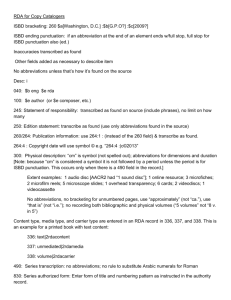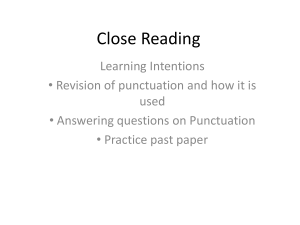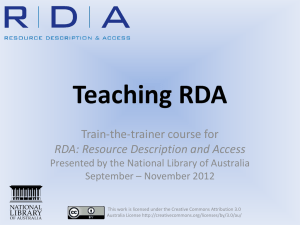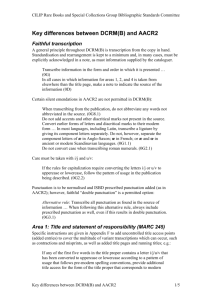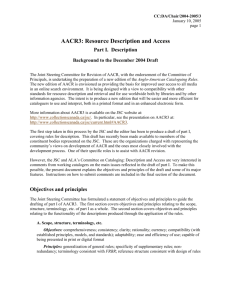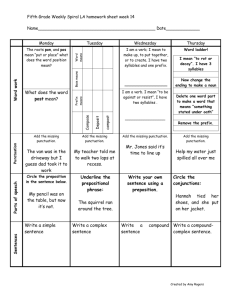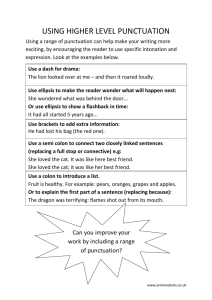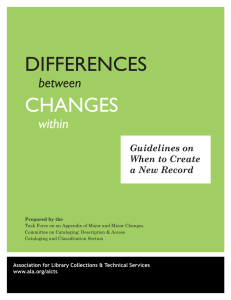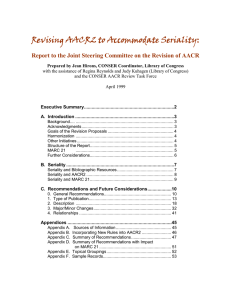LCRIpt1a - Yale University Library
advertisement
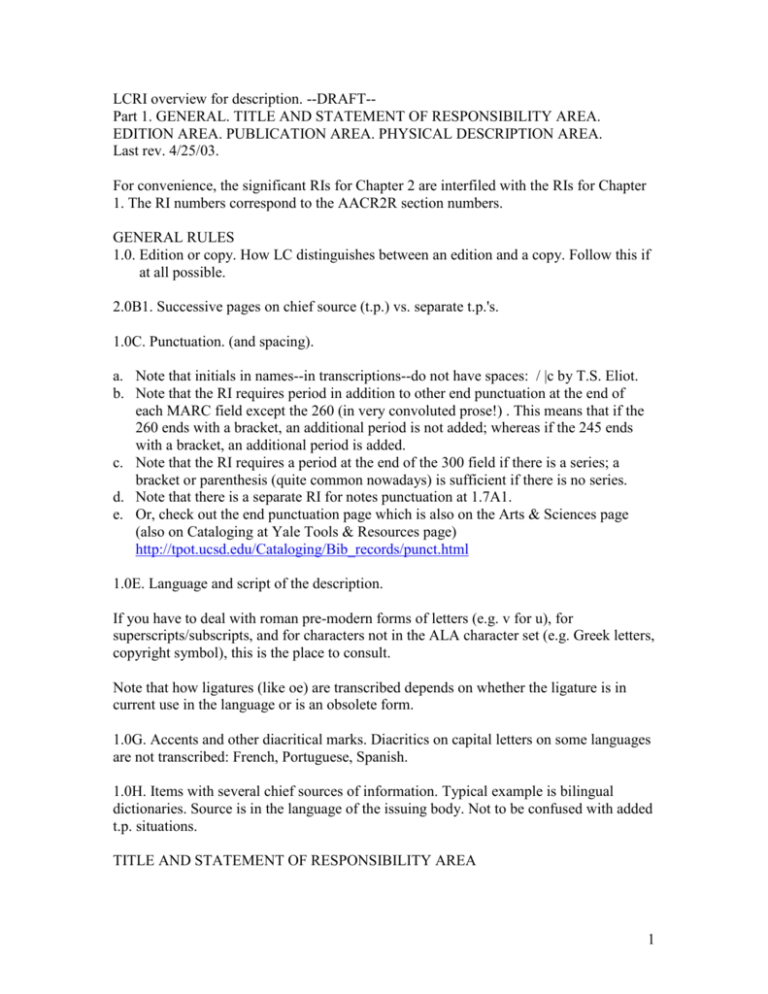
LCRI overview for description. --DRAFT-Part 1. GENERAL. TITLE AND STATEMENT OF RESPONSIBILITY AREA. EDITION AREA. PUBLICATION AREA. PHYSICAL DESCRIPTION AREA. Last rev. 4/25/03. For convenience, the significant RIs for Chapter 2 are interfiled with the RIs for Chapter 1. The RI numbers correspond to the AACR2R section numbers. GENERAL RULES 1.0. Edition or copy. How LC distinguishes between an edition and a copy. Follow this if at all possible. 2.0B1. Successive pages on chief source (t.p.) vs. separate t.p.'s. 1.0C. Punctuation. (and spacing). a. Note that initials in names--in transcriptions--do not have spaces: / |c by T.S. Eliot. b. Note that the RI requires period in addition to other end punctuation at the end of each MARC field except the 260 (in very convoluted prose!) . This means that if the 260 ends with a bracket, an additional period is not added; whereas if the 245 ends with a bracket, an additional period is added. c. Note that the RI requires a period at the end of the 300 field if there is a series; a bracket or parenthesis (quite common nowadays) is sufficient if there is no series. d. Note that there is a separate RI for notes punctuation at 1.7A1. e. Or, check out the end punctuation page which is also on the Arts & Sciences page (also on Cataloging at Yale Tools & Resources page) http://tpot.ucsd.edu/Cataloging/Bib_records/punct.html 1.0E. Language and script of the description. If you have to deal with roman pre-modern forms of letters (e.g. v for u), for superscripts/subscripts, and for characters not in the ALA character set (e.g. Greek letters, copyright symbol), this is the place to consult. Note that how ligatures (like oe) are transcribed depends on whether the ligature is in current use in the language or is an obsolete form. 1.0G. Accents and other diacritical marks. Diacritics on capital letters on some languages are not transcribed: French, Portuguese, Spanish. 1.0H. Items with several chief sources of information. Typical example is bilingual dictionaries. Source is in the language of the issuing body. Not to be confused with added t.p. situations. TITLE AND STATEMENT OF RESPONSIBILITY AREA 1 1.1B1. Use of ISBD punctuation in nonISBD transcription situations. Do you remember what to do with ellipses when transcribing ... in 245? Why do colons generally have to be substituted with alternate punctuation but not /s? 1.1D2. Follow the option chosen by LC for parallel titles, which is to transcribe the first parallel title and any subsequent title if it is in English. 1.1F1. What to transcribe for the statement of responsibility. Or, what not to transcribe. Editors worth transcribing or not worth transcribing. Mostly applies to roman script commercial publications? 1.1F5. Eliminating illustration statements like "With 117 photogravure plates" that appear on the t.p. 1.1G3. No collective title situation is common in research library original cataloging, so be sure to check out the AACR2 rule and the RI (for even weirder situations!) Be sure to consult also the MARC21 BIBLIOGRAPHIC FORMAT for the numerous examples for filing indicators and subfield tagging. Remember that initial articles are ignored in filing even if they are not in the nominative case. "In records formulated according to ISBD principles, subfield $a includes all the information up to and including the first mark of ISBD punctuation (i.e., an equal sign (=), a colon (:), a semicolon (;), or a slash (/)) or the medium designator (e.g., [microform])." <This means that the alternative title is in $a not $b> EDITION AREA [AACR2 1.2B1] Reminder: use prescribed abbreviations in this area as indicated in the appendices to AACR2. If the abbreviation is not on the list, it is written out. LCRI for Appendix C.8. Ordinal numbers: English: 1st ed., 2nd ed., 3rd ed. Other languages: 1. ed., 2. Aufl.. <use the prescribed abbreviation for the "edition" term, which in many cases depends on the language: there are different abbreviations for "edition" depending on the language. See AACR2 B.9. If the term is already abbreviated, use the abbreviation as found> 2.2. How LC handles mixed editions for multiparts, including how to handle the edition statement or use of note. 2 2.2B1. Gives additional examples of edition statements not covered by AACR2. Technically, the AACR2 rule would only transcribe 1st ed. if there was evidence that other editions of the work existed. Catalogers generally overlook this rule [intentionally or unintentionally] and in fact it is in the process of being overhauled to make it consistent with chapter 1. PUBLICATION AREA 1.4A2. Publisher on label or stamp if on chief source or verso. Not bracketed, but a note is added (unless core!) 1.4D1. Who is the publisher. For government printers and for privately printed works (which LC considers to be published). 1.4D2. Transcription of publisher name. Follow the RI rather than Maxwell, which is too prescriptive. Purpose of the RI is clearly to avoid the agonizing that trying to follow Maxwell would cause. 1.4D4. Formerly, there was an AACR2 rule to shorten the name of the publisher if it appeared in the 245. The rule is OBSOLETE with the AACR2 2002. This is a long RI but well worth reading! Record ALL the publishers if they appear on the chief source (cp. Maxwell). Note also that distributor is not recorded for items older than 3 years. 1.4F1. If nonGregorian and Gregorian date given, record only Gregorian. 1.4F5. Note that the RI says not to record copyright date after the publication date for books. 1.4F6. Use of copyright date as date of publication. 1.4F8. The rules and RIs for multiparts, updated with the AACR2 2002 amendments, are covered in detail in the separate multipart workflow document. 1.5E1. How to handle accompanying material. As note? As addition to physical description? Separately? PHYSICAL DESCRIPTION AREA 2.5B7. Unpaged books: use 1 v. (unpaged) 2.5B8. "If the volume has complicated or irregular pages, apply method c) only, [i.e.]: 1 v. (various pagings) 3 2.5B9. Loose-leaf publications follow different rules for physical description. There are detailed instructions for updating looseleafs available in a separate document on the Orbis2 page. 2.5B10. "Give the number of leaves or pages of plates after the paging if the leaves or pages are numbered. If the leaves or pages are unnumbered, give the number only when the plates clearly represent an important feature of the book. Otherwise, generally do not count unnumbered leaves or pages of plates." 2.5C2. "Describe an illustrated printed monograph or serial as "ill." in all cases unless there are maps present or 2.5C5 is applicable." 2.5C5 refers to situations where the item is, for example "chiefly ports." Note that a book which is chiefly music is a score and the scores format must be used. (Keep this also in mind when searching RLIN, since scores are in a different file until the anticipated update to the database scheduled for 2004). 4
